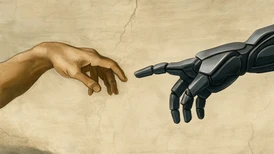UX vs AI: When Empathy Meets Algorithms
In recent years AI has swept in like a revolution, promising UX gold and efficiency gains, leading many to ask whether UX designers will be replaced and passed to history. The answer is a little more complex than a simple yes or no, and perhaps also more hopeful.

It’s true that AI can already assist with and streamline many aspects of UX design, but it’s not as simple as asking AI to create a service, pressing a button to launch it, and suddenly having happy users, skyrocketing conversions, and a flourishing brand. AI is powerful, but there are still many important ingredients where we UX designers are better; creativity, understanding context, and interpreting human nuance, to name a few.
AI can’t create, only recreate and imitate
AI is trained on what has already been made and approved for publication. That means it’s based on ideas that, for various reasons, were realized, not necessarily the best ideas. Many of the best ideas are still on the drawing board, waiting to come to life. While a designer’s DNA contains the drive to improve and innovate, AI reuses and imitates existing user and design patterns. Without human involvement and direction, we risk building the future on already made and outdated ideas. The result may be overly generic.
Of course, reusing and recreating has its place in the design process. Not every navigation menu, login, or contact form needs to be revolutionary, and some elements are perfectly fine to reuse. In fact, reusing frees up time to improve and develop other parts. But if we let AI take over the fundamental craftsmanship, we risk losing our role as conscious decision-makers, handing over our influence to tools that lack understanding of the context in which they operate. The danger is automating away both creativity and meaning — and with them, the human touch and positive user experience we strive for.
AI lacks human experience and empathy
UX design has always been about more than wireframes and usability tests. It’s about asking how we can make someone’s digital life a little easier, more intuitive, and more human. That requires empathy. Not just identifying “pain points,” but also trying to understand the context and emotional state of the person on the other side of the screen. AI doesn’t care about context, only patterns.
User experience is about more than click paths and flows; it’s about earning users trust and creating joy and a sense of security. These kinds of values cannot be fully quantified, and therefore they cannot be fully automated.
AI also inherits and imitates values, norms, and cultural assumptions. This can lead to misunderstandings and the opposite effect of what we want to achieve; user-friendly and accessible services that respect human values like equality, diversity, and inclusion.
Understanding how different users feel and behave under different circumstances isn’t just a nice touch, it’s a critical difference between technology that feels like a supportive friend and technology that feels rigid, bureaucratic, and intrusive. Making the user feel seen, understood and safe is always a vital part of UX design.
AI is a tool, not a UX designer
AI is a fantastic tool that helps us gain more insights in less time. It can assist in automating parts of our daily work, shortening project timelines, and enabling faster decision-making.
With AI, we are already analyzing user data and patterns more efficiently than before, and I also often use it to generate wireframes and create a prototype from conceptual sketches, allowing us to test the core idea with users early in the design process.
This provides better insights, saves time, and frees up space for more value-creating design iterations and better conditions for experimentation (e.g., A/B testing).
But to create a service that users truly love and use, it’s important for us as UX designers to be involved to ensure innovation, human judgment, empathy, and strategic understanding. AI doesn’t understand human nuance, so we must feed it the right conditions and train it on what we genuinely value and want to achieve. Our creativity, curiosity, and human qualities are the fuel for the fire.
So, will AI take UX designers’ jobs?
AI is a force that’s changing a lot, and as UX designers, we must remain curious, critical, and engaged, perhaps even thinking more empathetically than before. We need to adapt our role to the new reality, balance AI’s benefits with ethical considerations, and let AI boost our creativity. Not replace it.
AI in UX design isn’t just a trend, it’s a power that is reshaping how we design and experience digital products, and we must embrace that power. AI is not our enemy, but indifference to change is.
We are not facing replacement. We are facing the opportunity to boost the value of our human expertise.
Ps. The image above is AI-generated. I asked the AI to create an image that symbolize the connection between a human and a robot (I used robot, since AI is so abstract). Prompt: "Create an image that symbolizes the interaction between human and robot, in the style of an old painting by one of the great masters".
Well, you have seen that image before, right? Of course you have, because similar images has been done before...

We would like to hear what you think about the blog post